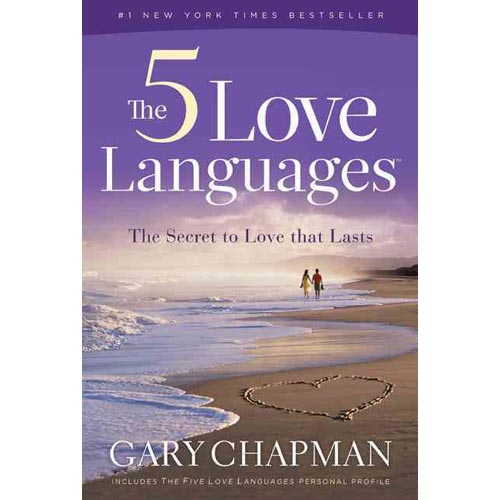 What happens to love after the wedding? Why does it seem to just evaporate? These are some of the questions that Dr. Gary Chapman attempts to answer in The 5 Love Languages: the Secret to Love That Lasts. Fortunately he also provides a prescription for keeping love alive.
What happens to love after the wedding? Why does it seem to just evaporate? These are some of the questions that Dr. Gary Chapman attempts to answer in The 5 Love Languages: the Secret to Love That Lasts. Fortunately he also provides a prescription for keeping love alive.
According to Chapman each of us experiences love differently. Some of us really feel loved when someone spends time with us. Others feel love when they are given a gift by that special someone. Not only do we experience love differently, but we usually express love in ways that are meaningful for us. So, if I feel loved when I receive gifts I will often give gifts as an expression of my love. But what if the other person doesn’t experience love when they receive a gift? What if they want me to spend time with them? This, according to The 5 Love Languages, is the problem with many relationships and the reason love seems to fade: each person is speaking a different “love language.”
The five love languages that Gary Chapman identifies are: 1) words of affirmation, 2) quality time, 3) receiving gifts, 4) acts of service, and 5) physical touch.
Words of affirmation. This love language actually uses words. Love is expressed by telling the other person how much they are valued and appreciated. But it’s important not to just value them for what they do, but for who they are. A wife doesn’t want to know that she is valued because of all the cooking and cleaning she does, but because she is a valuable, unique, and beautiful person.
Quality Time. Here love is expressed by spending time with the other person. Your presence communicates that you enjoy them and want to be with them. The time spent together participating in some activity creates a shared experience—something that the two of you share— and that strengthens the relationship.
Receiving Gifts. Jewelers would like us to believe that this is the only true way to express love and commitment. Love is expressed through giving and receiving gifts. Although it isn’t the only love language, it is an important one—for some people.
Acts of Service. People are sometimes surprised when they hear that acts of service is one of the love languages. Here love is expressed by doing something for the other person—and these acts of service don’t have to be huge. Husbands, if your wife has this love language you can show your love to her by taking out the trash!
Physical Touch. Of course the sexual component of marriage is an important one, and this love language includes that aspect. But showing love through physical touch is much broader than that one act. It includes a gentle kiss, holding hands, a pat on the back, and snuggling together on the couch. Fathers and sons are engaging in this love language when they wrestle on the floor.
In the 5 Love Languages Gary Chapman contends that not speaking the love language of the other person lies at the root of almost all marriage problems. He also introduces another concept to help explain and illustrate: the “love tank.” When our love tank is full we feel loved, appreciated, and cared for. When the love tank is low we don’t feel loved, we don’t feel appreciated, and we don’t feel cared for. The problem is we can’t fill our own love tank—that has to be done for us. Our love tank is filled when someone else who is important in our life speaks our love language to us. And our partner’s love tank is filled when we speak their love language to them. And this brings up a crucial point. I tend to speak my love language to my mate because it’s the language I know. But if my love language is not theirs, they will not experience being loved. I can give gifts all day long, but if my partner doesn’t have receiving gifts as one of their love languages they will never experience the love that I’m showing, and consequently will never have their love tank filled. This is the problem with many relationships. We don’t think we should work at it—love should be obvious. But the fact is we do need to work at showing love by consciously using the love language of our spouse. Of course this fits very well with the Biblical instruction that husbands and wives should submit to one another, taking each other into account and loving each other (Ephesians 5:21-33).
The Five Love Languages books have been amazingly popular. As of Jan 1, 2012 this newest edition, The 5 Love Languages: the Secret to Love That Lasts, has spent 230 weeks on one or another version of the New York Times best sellers lists. This book is a newer edition of The Five Love Languages: How to Express Heartfelt Commitment to Your Mate which was first published in 1992. The content is the same except that the chapter on the Love Languages and Children has been removed. (That information was expanded and produced the book The Five Love Languages of Children.) In addition, the newer edition no longer includes the Study Guide for Spouse and Group Discussion (a small group version of the book is available). But two important instruments have been added. The book now includes a profile for the husband and a profile for the wife. These can be used to easily determine the love languages of each.
A number of other books have been spawned by the amazing popularity and usefulness of the 5 love languages. There are now “Five Love Language” books for children, teens, men, and singles. In addition these principles are used to illuminate our relationship with God—he speaks our love language, and to explain the process of giving and receiving forgiveness.
Each of these books are available from our Resources page (under the category Relationship Skills) or by following the links above. You also might be interested in my review of The 5 Love Languages DVD Small Group Curriculum.




Pingback: The 5 Love Languages DVD Small Group Curriculum | Books and Curriculum
Pingback: Free 5 Love Languages Study Guides | Books and Curriculum